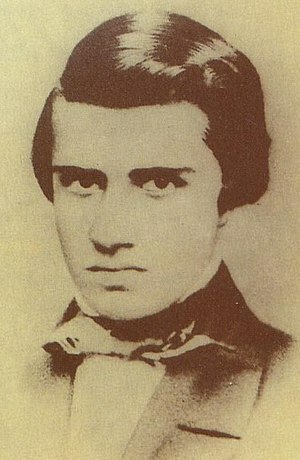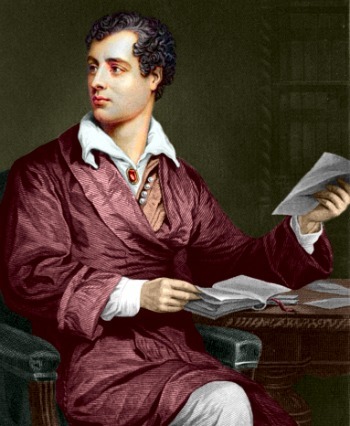Dom Pedro II (or Pedro II of Brazil) was the second and last Emperor of Brazil.
He ascended the throne in 1840 and was at the head of the country until 1889, when the coup that installed the Republic occurred.
Following Portuguese and royal traditions, the heir to the throne was given several names in order to honor his grandparents, saints and angels.
His full name was: Pedro de Alcântara João Carlos Leopoldo Salvador Bibiano Francisco Xavier de Paula Leocádio Miguel Gabriel Rafael Gonzaga de Bragança and Bourbon.
Biography of Dom Pedro II
 Portrait of Dom Pedro II
Portrait of Dom Pedro II
Born on December 2, 1825, at Quinta da Boa Vista Palace, in Rio de Janeiro, Dom Pedro II was the son of Dom Pedro I, the first Emperor of Brazil, and of Empress D. Maria Leopoldine.
He was the couple's seventh child, but became an heir as his older brothers, Miguel and João Carlos, died.
His mother passed away when he was about a year old. Later, his father would leave him at the age of five, go off to conquer the Portuguese throne, and there he would die when he was nine.
For this reason, he had a difficult childhood, although he received an exemplary education. During his training, he took classes in arts, history, geography, natural sciences, letters, languages, horseback riding and fencing.
In 1831, Dom Pedro I abdicated the Brazilian throne and returned to Portugal in order to guarantee the Portuguese throne for his eldest daughter, Dona Maria II. Thus, Dom Pedro remained in Brazil being appointed prince regent, with only 5 years of age.
In Brazil, he was first under the tutelage of José Bonifácio de Andrade e Silva and, later, of Manuel Inácio de Andrade Souto Maior, marquis of Itanhaém.
Due to the civil wars that took place in the regency period, the liberal group managed to bring the prince's majority to maturity. Therefore, he assumes the throne in 1840, just before his 15th birthday.
Marriage and children
In 1843, he married Princess Teresa Cristina Maria de Bourbon, daughter of Francis I of the Two Sicilies, King of the Two Sicilies, and of the Infanta Maria Isabel of Spain.
With Empress Teresa Cristina he had 4 children:
- Afonso Pedro (1845-1847), Prince Imperial
- Isabel do Brasil (1846-1921), Princess Imperial
- Leopoldina do Brasil (1847-1871), Princess of Brazil
- Pedro Afonso (1848-1850), Prince Imperial
Only the girls, Isabel and Leopoldina, reached adulthood. Isabel would be heir to the throne and would exercise the regency on three occasions. Leopoldina, on the other hand, married the German prince Luís Augusto de Saxe-Coburgo-Gota and lived in Europe until her death in 1871.
In 1886, Dom Pedro II traveled to Europe to take care of his health and visit various places of historical and scientific interest. In its place was the Princess Isabel, responsible for signing the abolitionist laws such as the Lei do Ventre Livre, in 1871 and the Lei Áurea, in 1888.
With the republican coup on November 15, 1889, the imperial family was expelled from Brazil and went to Europe. In France, Dom Pedro II died on December 5, 1891, victim of pneumonia, aged 66 years.
Government of Dom Pedro II
Dom Pedro II ruled Brazil for 49 years, from 23 July 1840 to 15 November 1889, when the Republic was proclaimed. This period was known as the Second Reign.
Through the "Coup of Age” was appointed emperor on July 23, 1840, when he was just 14 years old.
According to the Constitution implemented by his father, the emperor Dom Pedro I, in 1824, the majority of the heir was reached with 21 full years. The Declaration of Majority, therefore, allowed him to rule the country before this age.
Note that this declaration was a strategy of the liberal party, which had the intention of ending the Regency Period in Brazil. During this period, the country was governed by political groups (liberal and conservative) that defended different principles.
With the Coup of Majority, the regency period (1831-1840) ended in the country, giving way to the Second Reign.
During his government, D. Pedro II focused on the country's economic and social development, with the first telegraph lines and the first railway in the country being built.
It was during this period that abolitionist laws advanced:
- Bill Aberdeen Law (1845);
- Eusébio de Queirós Law (1850);
- law of the free womb (1871);
- Sexagenarian Law (1887);
- Golden Law (1888).
He traveled to different parts of the country and the world in order to learn about the various technological innovations and bring them to his home country. During this period, he left his daughter Isabel as regent of the country.
During his government, there were several revolts of which the following stand out:
- Revolta dos Liberais (1842), in Minas Gerais and São Paulo;
- War of the Rags (1845), in Rio Grande do Sul;
- beach revolution (1848), in Pernambuco.
He won some important wars such as the Prata War (War against Oribe and Roses) in 1850; the Uruguay War (War against Aguirre) in 1864; and the Paraguay War (1865).
At the end of his government, he suffered a coup in the November 15, 1889, which resulted in exile in Europe.
After the installation of the republic he was forced to leave the country and went to Portugal with his family. Later, he would live in France and die in Paris, shortly after his 66th birthday.
We have more texts on this subject for you:
- Governing Period
- first reign
- second reign
- Moderating Power
- Proclamation of the Republic
- Monarchy
- Aristocracy
- Brazil
Curiosity
As an icon in the history of Brazil, there are several streets, avenues, commercial, hospital and educational centers that bear his name.



